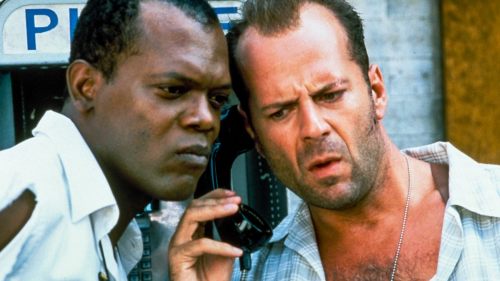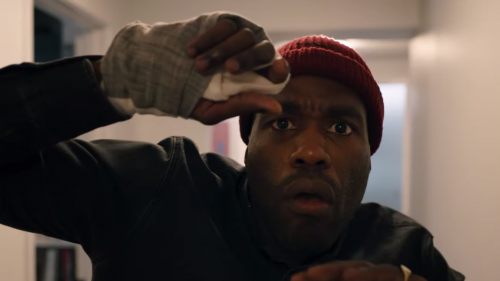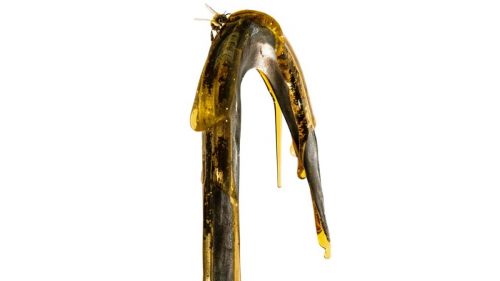Stories We Tell: CANDYMAN At 25
They're passed down through word of mouth like the old telephone game you used to play as a kid. You heard the story from Bobby, who has a friend who knew the brother of the girl who was killed (or something like that, you can't quite recall). Bars and parties become campfires, as lecture halls dissect the very nature of "urban legends" in an academic fashion, never letting us forget that they're 100% "not true". A student may claim that they read that alligators really do exist in the sewers of New York (or was it LA? Again, the details are hazy) in the papers, but that's all bullshit. Furthermore, there's no such thing as the "Candyman" - the killer spirit with a hook for a hand who appears after you say his name into a mirror five times before turning off the lights. He's a myth; a bedtime story told to spook children. Nothing more.
In Clive Barker's original short story "The Forbidden", the Candyman isn't black - he's a blonde haired white man who exists in the British slums. Much of the infamous horror author's narrative structure remains the same in Bernard Rose's '92 film adaptation. A university student named Helen (played by Virginia Madsen) is researching a project on street graffiti, which leads her to the origins of the legendary boogeyman. However, when the English filmmaker brought Barker's story to America, he set it in Chicago's infamous Cabrini-Green housing projects, instantly changing the hook-handed haunt into a persecuted African-American, altering the dynamics of the story forever. "The Forbidden" was now Candyman, and it was no longer simply about the modern scary stories society authors, but also how they're interpreted between tribes.
In Rose's film, Helen is now a graduate student at the University of Illinois, working on a thesis regarding urban legends with her colleague Bernadette (Kasi Lemmons), a black woman who is equally (if not more) frightened by the prospect of exploring the projects. Helen relays a story the cleaning woman told her late one night while she was transcribing one of their interviews (a white girl whose suburban iteration of the legend plays more like "Bloody Mary" than anything). But there's genuine fear in the custodian's eyes, as her iteration takes on a much more sinister, real world tone - Ruthie Jean was a woman, home alone in her Cabrini-Green apartment, who called the cops twice when she thought she heard someone breaking in. But the police responded late (as they often do in that neighborhood), arriving to find the girl split from groin to gullet with a hook. Candyman got her.
From the start, Rose's picture (which he also penned the screenplay for) is setting up a racial schism for the way the Candyman's existence is translated between Caucasians and People of Color. The white student's take is set in a Lynchian white picket fence-lined suburb, where the local bad boy (hilariously played by Ted "Brother of Sam" Raimi) rides up on his motorcycle, only to have his virginal conquest gutted after they foolishly play the "Candyman" game together in the upstairs bathroom. It's clearly the invention of a sheltered mind, sourcing a fourth-hand telling of the tale. The custodian's take is all too easy to confirm, as Helen discovers clippings of Ruthie Jean's tragic murder in the school's periodical archive, and confirms the killer's entryway via a design flaw in her own condo.
Beyond race, Helen's investigations also reveal the ways these myths travel across economic divides. The flaw in her apartment involves a medicine cabinet mirror, which can be removed with a slight push due to its shoddy installation. Turns out her building was originally intended to be a housing project by the city, but was later converted into luxury flats because of its adjacency to one of Chicago's wealthiest neighborhoods (the ritzy Gold Coast). But this same failing connected two apartments, and allowed a prowler to invade Ruthie Jean's apartment, making her part of an urban legend in a housing project that's only deemed as such because of its location on the Near North Side, which is predominately populated by African-Americans. Just as a project becomes a condo because of its location, a boogeyman is suddenly made flesh, due to the same's ill-conceived construction schematics.
Perhaps the moment that best illustrates what Candyman means to Helen and her mostly white, privileged academic peers is presented in the form of a condescending professor (Michael Culkin), who lays out the history behind the titular spectral killer in a moment of pure intellectual oneupsmanship (as Helen threatens to "bury" his previous work on the subject). Candyman was the son of a slave who became rich after developing a system for mass-producing shoes during the Civil War. As a result of his father's wealth, the black boy grew up in polite society and was a well-known artist, sought after for his painterly talents. In 1890, he fell in love and fathered a child with a white woman, causing her daddy to hire a lynch mob, who cut off his brush hand and replaced it with a hook. Smeared with honey stolen from an apiary, the locals dubbed him "Candyman", as hungry bees stung him to death. His corpse was burned on a pyre and his ashes were scattered across the area where Cabrini-Green now stands.
The disconnect is clear. Here is a collection of white folks, gathered in a fancy restaurant, glibly discussing a tale of racial atrocity while waiting for their next course. Meanwhile, in Cabrini-Green, the local drug lords have adopted the legend as a means to intimidate anyone who dares try and snitch to the cops about their business. In possibly the most grotesque sequence in Candyman, Jake (DeJuan Guy) - a young boy who calls the projects home - takes Helen to a bathroom where the real life "Candyman" cut the penis off of a young mentally handicapped boy, as a means to showcase his capacity for cruelty to the fearful neighborhood. Immediately after, Helen comes face to face with the dealer (Terrence Riggins) and his gang, who beat the woman half to death and leave her unconscious on the shit-stained floor. We're not at dinner anymore. This is how a story actually lives.
Perhaps the most brazen element of Candyman is how it waits to introduce the boogeyman (played to gravel-voiced perfection by Tony Todd*), who starts to haunt Helen following her fingering of the man who assaulted her. Up until this point, Rose's film really only seems to be about a white woman exploring the overwhelming otherness of the ghetto, fetishizing a mythology that actually means a great deal to the people who live where ghastly violence continues to be committed against their own. But the most ingenious twist in Rose's adaptation is its attempts to understand what the legend means to the monster himself, who cannot abide folks disbelieving his myth.
"I am the writing on the wall, the whisper in the classroom. Without these things, I am nothing." Though Candyman often speaks in the disjointed rhythms of a bad poet, his words are no less true. Before the ghosts appears, he is little more than a spray-painted visage on the other side of a murder scene's wall, or the gang tag "sweets to the sweet", scribbled in colorful paint and human feces. Once Helen outs her attacker as nothing more than someone exploiting the Candyman's minted myth, he must seek revenge on the woman and make her his victim. Only, she cannot just die, but must also commit further heinous crimes as a means of authoring another chapter that continues the longevity of his name. Like the gang member, Candyman's got a rep to uphold, and he's going to drive Helen mad in order to do so.
There's a jagged, psychedelic element to the second half of Candyman, as cinematographer Anthony B. Richmond alternates between frenzied realism during grisly scenes of gore (a moment involving a dog's severed head is wholly unsettling) and flashes of disorienting, everyday surrealism (just look at those police lights on Helen's face). Candyman literally floats in and out of these instances, taunting Helen about a missing baby (whom he stole from Vanessa Williams' cowering Cabrini-Green single mother) and offering to trade the infant for the white woman's life. All the while, we're left to wonder if this poor academic somehow lost her mind while spelunking in a culture she kept at arm's length via thesis papers and dissertations. The reality of her beloved myth was too much to handle, causing her to become a fleshy extension of its horror, taking lives she can't remember due to "blacking out".
As Helen struggles with her sanity, and Candyman's brutal crimes splatter blood across apartment floors and the desks of prison psychologists, Philip Glass' distorted organ and choir score booms, adding a layer of Gothic histrionics to the proceedings that's truly unforgettable. Candyman is a visual marvel, its gliding aerial photography capturing the city of Chicago in a way it'd never been portrayed on film up until this point. But it's Glass' ominous, dread-filled score that makes every nook and cranny of the city feel like it hides horrors beyond the usual crime and punishment they usually have to offer.
Cabrini-Green was fully demolished in 2011, and the nearby William Green projects have been renovated into a combination of upscale high-rise buildings and row houses. But Chicago's legendary violence continues, shifting from the Near North Side to the South Side, which doesn't seem to miss the news for a single day in 2017, thanks to its notorious murder rate. Perhaps this is why Candyman is still the ultimate Windy City horror film, as its central beast represents more than just a vengeful ghost; it stands for the brutality that's been mythologized by white academics and media elites alike. By transposing Barker's short story onto an environment in which it was never intended to be told, Bernard Rose created the perfect cinematic representation of the urban legend - a campfire story white people tell each other, while those living with horror every day know that it's all too real, and they don't need the news to confirm it.
*Thank God Eddie Murphy's pay grade was above the film's $8 million budget.



